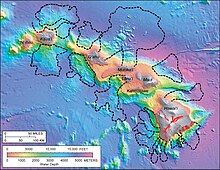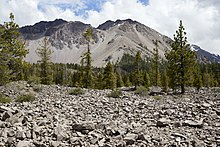Volcanic landslide

Avolcanic landslideorvolcanogenic landslideis a type ofmass wastingthat takes place atvolcanoes.
Occurrences
[edit]
All volcanic edifices are susceptible tolandslides,particularlystratovolcanoesandshield volcanoeswhere landslides are important processes.[1]Volcanic landslides range in size from less than 1 km3(0.24 cu mi) to more than 100 km3(24 cu mi).[2]The largest volcanic landslides on Earth occur fromsubmarine volcanoesand are several times larger than those that occur on land.Submarine landslideswith volumes of 100–150 km3(24–36 cu mi) have occurred in theCanary Islandswithin the last 43 million years, but the largest submarine landslides could have been up to 900 km3(220 cu mi) in volume.[3]Massive submarine landslides have also taken place in theHawaiian Islandsover the last several million years, the largest of which constitute significant portions of the islands from which they originated.[4]
Smaller landslides have also been identified at volcanoes onMarsandVenus.[5][6]Martian landslides reach lengths of 90 km (56 mi) and more while the largest Venusian landslides extend only about 50 km (31 mi). The most dramatic landslide deposits on Venus occur beneath the slopes of volcanoes. Since erosion rates on Venus are much lower than those on Earth due to the lack of water on the surface, landslides are an important mechanism in wearing down mountain regions on Venus. The rounded hills of the complexly deformedtessera,or tile-like, terrain on Venus have probably been modified by numerous landslides.[6]
Types
[edit]

At volcanoes, the term landslide is commonly used for slope movements with shear and displacement in a relatively narrow zone.[7]They can be in the form ofdebris avalanches,debris flows,slumpsandrockfalls.[7][8]A debris avalanche is a sudden, very rapid flow of rock and soil in response to gravity. It is a common middle stage in the transformation of a cohesive debris flow from a landslide or rockslide. Debris avalanches may be restricted to grain flows or granular flows, in which flow mechanics are governed by particle interactions involving friction and collision. Debris flows, in contrast, owe much of their behaviour to excess pore-water pressure and a pore fluid that is viscous and contains fine sediment.[7]
Sector collapses
[edit]The largest landslides from volcanoes are called sector or edifice collapses.[7]Prehistoric sector collapses are preserved in thegeological recordin the form of debris avalanche deposits and collapse scars.[9][10][11]Debris avalanche deposits can be found up to 20 km (12 mi) from the site of collapse. Collapse scars are also an indicator of sector collapse and are often described as "amphitheatre"or"horseshoe"shaped.[11]Such collapse scars, open at one end, have long been noted in many volcanic regions around the world.[2]The largestvolcanic islandsector collapse in historic times took placein 1888whenRitter Islandcollapsed off the northern coast ofPapua New Guinea.[12][13]Edifice reconstruction generally must occur before a second sector collapse.[7]
- Prehistoric
- Stromboli,Sciara del Fuococollapse[14]
- Popocatépetl,Ventorrillo collapse[15]
- Mount Rainier,Osceola collapse[16]
- Historic
Flank collapses
[edit]
Flank collapses are much smaller than sector collapses, but they may also yield far-reaching debris flows. Flank collapses differ from sector collapses in that they only involve the volcano flank while sector collapses are large enough to involve the volcano summit. The smaller size of a flank collapse indicates that there need be no repose time before another flank collapse occurs, and hence they can be treated as random events.[7]
- Prehistoric
- East Molokai Volcano,Wailau collapse[17]
- Koʻolau Volcano,Nuʻuanu collapse[18]
- Mount Garibaldi,Cheekye collapse[19]
- Historic
Causes
[edit]
Several conditions can trigger landslides at volcanoes:
- Intrusion ofmagmainto a volcano[2]
- Explosive eruptions[2]
- Largeearthquakedirectly beneath a volcano or nearby[2]
- Saturation of the ground[2]
- Hydrothermal alterationofvolcanic rocks[2]
- Structural discontinuities[22]
- Highlavaaccumulation rates[22]
- Steep slopes[2]
Hazards
[edit]
Large landslides from volcanoes often bury valleys with tens to hundreds of metres of rock debris, forming a chaotic landscape marked by dozens ofsmall hillsand closed depressions. If the landslide deposit is thick enough, it may dam streams to form lakes. These lakes may eventually drain catastrophically to createfloodsandlaharsdownstream.[2]
Landslides that remove a large portion of avolcanic conemay abruptly decrease pressure on shallow magmatic and hydrothermal systems, which can generate explosions ranging from a small steam explosion to large steam and magma-driven directed blasts. These result intephraandash fallhazards for surrounding areas.[2]
Large horseshoe-shaped craters formed by landslides at volcanoes will likely direct subsequent lava flows,pyroclastic flowsor lahars toward its breached opening if the primary eruptive vent is located within these deep craters.[2]
The collapse of island or coastal volcanoes from giant landslides can generatetsunamisthat could potentially devastate large areas of coastal land.[23]
Disasters
[edit]
Historically, the most deadly volcanic landslide occurredin 1792when sliding debris from Mount Mayuyama in Japan slammed into theAriake Seaand generated a tsunami that reached the opposite shore and killed nearly 15,000 people.[2]
The sector collapse of Ritter Island in 1888 generated a tsunami with runups of up to 15 m (49 ft) that caused damage more than 700 km (430 mi) away and killed anywhere between 500 and 3,000 people on neighbouring islands.[24][25][26]
A landslideoriginating from Devastation Glacier on the southern flank of theMount Meager massifinBritish Columbia,Canada, buried and killed a group of four geologists at the confluence of Devastation Creek andMeager Creekin July 1975.[27][28]
In 1979,a landslidefrom the Indonesian volcanoIliwerungproduced 9 m-high (30 ft) waves that killed more than 500 people.[29]In December 2018, another landslide-induced tsunami took place in Indonesia'sSunda Straitfollowing a collapse ofAnak Krakatoa.[30]The waves struck about 313 km (194 mi) of coastline with various heights, killing at least 373 people and damaging many buildings.[31][32]
See also
[edit]References
[edit]![]() This article incorporatespublic domain materialfrom websites or documents of theUnited States Geological Survey.
This article incorporatespublic domain materialfrom websites or documents of theUnited States Geological Survey.
- ^"Volcanic Processes—Landslides".National Park Service.Retrieved14 April2023.
- ^abcdefghijkl"Landslides are common on tall, steep, and weak volcanic cones".United States Geological Survey.Retrieved2023-03-27.
- ^"The planet's largest landslides happen on submarine volcanoes".National Oceanography Centre.2017-12-12.Retrieved2023-04-02.
- ^"Volcano Watch — Slip-sliding away—Disassembling Hawaiian volcanoes".United States Geological Survey.2014-01-23.Retrieved2023-04-02.
- ^McGuire, W. J. (1996). "Volcano instability: a review of contemporary themes".Geological Society Special Publication.110.Geological Society of London:1–23.doi:10.1144/GSL.SP.1996.110.01.01.S2CID128674065.
- ^ab
 This article incorporatespublic domain materialfrom websites or documents of theNational Aeronautics and Space Administration.Cleggett-Halaim, Paula; Doyle, Jim (1992)."Large Landslides Found on Venus".NASA.Retrieved14 April2023.
This article incorporatespublic domain materialfrom websites or documents of theNational Aeronautics and Space Administration.Cleggett-Halaim, Paula; Doyle, Jim (1992)."Large Landslides Found on Venus".NASA.Retrieved14 April2023.
- ^abcdefScott, Kevin M.; Macías, José Luis; Naranjo, José Antonio; Rodríguez, Sergio; McGeehin, John P. (2001). Catastrophic Debris Flows Transformed from Landslides in Volcanic Terrains: Mobility, Hazard Assessment, and Mitigation Strategies (Report).United States Geological Survey.p. 6.ISBN0-607-98578-X.
- ^Rault, C.; Thiery, Y.; Chaput, M.; Reninger, P. A.; Dewez, T. J. B.; Michon, L.; Samyn, K.; Aunay, B. (2022)."Landslide Processes Involved in Volcano Dismantling From Past to Present: The Remarkable Open-Air Laboratory of the Cirque de Salazie (Reunion Island)"(PDF).Journal of Geophysical Research: Earth Surface.127(5).American Geophysical Union:1.doi:10.1029/2021JF006257.S2CID248353147.
- ^abcdWatt, Sebastian F. L. (2019-10-15)."The evolution of volcanic systems following sector collapse".Journal of Volcanology and Geothermal Research.384:280–303.doi:10.1016/j.jvolgeores.2019.05.012.ISSN0377-0273.S2CID181821094.
- ^Kervyn, M.; Ernst, G. G. J.; Klaudius, J.; Keller, J.; Mbede, E.; Jacobs, P. (2008-10-28). "Remote sensing study of sector collapses and debris avalanche deposits at Oldoinyo Lengai and Kerimasi volcanoes, Tanzania".International Journal of Remote Sensing.29(22): 6565–6595.Bibcode:2008IJRS...29.6565K.doi:10.1080/01431160802168137.ISSN0143-1161.S2CID128817424.
- ^abRomero, Jorge E.; Polacci, Margherita; Watt, Sebastian; Kitamura, Shigeru; Tormey, Daniel; Sielfeld, Gerd; Arzilli, Fabio; La Spina, Giuseppe; Franco, Luis; Burton, Mike; Polanco, Edmundo (2021)."Volcanic Lateral Collapse Processes in Mafic Arc Edifices: A Review of Their Driving Processes, Types and Consequences".Frontiers in Earth Science.9.doi:10.3389/feart.2021.639825.ISSN2296-6463.
- ^Karstens, Jens; Berndt, Christian; Urlaub, Morelia; Watt, Sebastian F.L.; Micallef, Aaron; Ray, Melanie; Klaucke, Ingo; Muff, Sina; Klaeschen, Dirk; Kühn, Michel; Roth, Theresa; Böttner, Christoph; Schramm, Bettina; Elger, Judith; Brune, Sascha (2019)."From gradual spreading to catastrophic collapse – Reconstruction of the 1888 Ritter Island volcanic sector collapse from high-resolution 3D seismic data"(PDF).Earth and Planetary Science Letters.517:1–13.Bibcode:2019E&PSL.517....1K.doi:10.1016/j.epsl.2019.04.009.ISSN0012-821X.S2CID150016618.
- ^"When Volcanoes Fall Down—Catastrophic Collapse and Debris Avalanches"(PDF).Fact Sheet 2019–3023.United States Geological Survey.2019.Archived(PDF)from the original on 2020-03-06.Retrieved2021-02-07.
- ^Kokelaar, Peter; Romagnoli, Claudia (1995-08-01)."Sector collapse, sedimentation and clast population evolution at an active island-arc volcano: Stromboli, Italy".Bulletin of Volcanology.57(4): 240–262.Bibcode:1995BVol...57..240K.doi:10.1007/BF00265424.ISSN0258-8900.S2CID128687255.
- ^Gisbert, Guillem; Delgado-Granados, Hugo; Mangler, Martin; Prytulak, Julie; Espinasa-Pereña, Ramón; Petrone, Chiara Maria (2022)."Evolution of the Popocatépetl Volcanic Complex: constraints on periodic edifice construction and destruction by sector collapse".Journal of the Geological Society.179(3).doi:10.1144/jgs2021-022.S2CID244445941.
- ^Vallance, James W.; Scott, Kevin M. (1997)."The Osceola Mudflow from Mount Rainier: Sedimentology and hazard implications of a huge clay-rich debris flow"(PDF).GSA Bulletin.109(2): 143–163.doi:10.1130/0016-7606(1997)109<0143:TOMFMR>2.3.CO;2.
- ^Clague, David A.; Moore, James G. (2002). "The proximal part of the giant submarine Wailau landslide, Molokai, Hawaii".Journal of Volcanology and Geothermal Research.113(1–2): 249–287.doi:10.1016/S0377-0273(01)00261-X.
- ^"Koolau: General Information".Global Volcanism Program.Smithsonian Institution.Retrieved2023-04-07.
- ^Friele, Pierre A.; Ekes, C.; Hickin, E.J. (1999). "Evolution of Cheekye fan, Squamish, British Columbia: Holocene sedimentation and implications for hazard assessment".Canadian Journal of Earth Sciences.36(12).Natural Resources Canada:2023.doi:10.1139/e99-090.
- ^Guthrie, R. H.; Friele, P.;Allstadt, K.;Roberts, N.; Evans, S. G.; Delaney, K. B.; Roche, D.; Clague, J. J.; Jakob, M. (2012)."The 6 August 2010 Mount Meager rock slide-debris flow, Coast Mountains, British Columbia: characteristics, dynamics, and implications for hazard and risk assessment".Natural Hazards and Earth System Sciences.12(5).Copernicus Publications:1277–1294.Bibcode:2012NHESS..12.1277G.doi:10.5194/nhess-12-1277-2012.ISSN1561-8633.
- ^"Large Landslide in Uganda".NASA Earth Observatory.13 March 2010.Retrieved2023-04-08.
- ^abParis, Raphaël (2015), "Source mechanisms of volcanic tsunamis",Philosophical Transactions of the Royal Society,373(2053),Royal Society Publishing,Bibcode:2015RSPTA.37340380P,doi:10.1098/rsta.2014.0380,PMID26392617,S2CID43187708
- ^"How do landslides cause tsunamis?".United States Geological Survey.Retrieved2023-03-27.
- ^Siebert, Lee; Reid, Mark E.; Vallance, James W.; Pierson, Thomas C. (2019)."When Volcanoes Fall Down—Catastrophic Collapse and Debris Avalanches"(PDF).U.S. Geological Survey.Fact Sheet 2019–3023.Archived(PDF)from the original on 2020-03-06.Retrieved2021-02-07.
- ^Paris, Raphaël; Switzer, Adam D.; Belousova, Marina; Belousov, Alexander; Ontowirjo, Budianto; Whelley, Patrick L.; Ulvrova, Martina (2014)."Volcanic tsunami: a review of source mechanisms, past events and hazards in Southeast Asia (Indonesia, Philippines, Papua New Guinea)"(PDF).Natural Hazards.70:447–440.doi:10.1007/s11069-013-0822-8.S2CID73610567.
- ^"NCEI Global Historical Hazard Database".www.ngdc.noaa.gov.Retrieved2021-02-06.
- ^"Landslide: Devastator Glacier BC, Jul 22 1975".Natural Resources Canada.2009-12-01.Retrieved2023-04-14.
- ^Simpson, K.A.; Stasiuk, M.; Shimamura, K.; Clague, J.J.; Friele, P. (2006). "Evidence for catastrophic volcanic debris flows in Pemberton Valley, British Columbia".Canadian Journal of Earth Sciences.43(6).NRC Research Press:688.doi:10.1139/e06-026.ISSN0008-4077.
- ^Keeley, J. (2010)."Volcanogenic Tsunamis".Oregon State University.Retrieved2021-04-27.
- ^Permadi, Agie (26 December 2018)."Longsoran yang Sebabkan Tsunami Selat Sunda Seluas 64 Hektar".Kompas(in Indonesian).Archivedfrom the original on 11 January 2019.Retrieved11 January2019.
- ^"Number of injured in Indonesia tsunami surges to over 14,000 — Asean Plus | the Star Online".Archivedfrom the original on 18 April 2019.Retrieved13 April2023.
- ^Marten, Lisa; Zhou, Naaman (24 December 2018)."Indonedia tsunami caused by collapse of volcano".The Guardian.Retrieved13 April2023.
